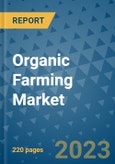The global organic farming market, which was valued at USD 102.1 billion in 2021, is set to witness significant growth with a projected CAGR of 10.3 percent during the forecast period. Organic farming, which involves the production of crops and livestock without the use of artificial fertilizers, pesticides, genetically modified organisms, and antibiotics, is gaining traction due to its various benefits to the environment and consumers.
Environmental Gains Propel the Organic Farming Market
The adoption of organic farming practices is anticipated to drive environmental benefits, such as reduced soil and groundwater contamination. With no chemical fertilizers or pesticides used in organic farming, it conserves the biodiversity of the soil, making it highly beneficial to the environment.Changing Dietary Patterns Boost Demand for Organic Food Products
Shifting dietary patterns towards organic food products are driving the demand for organic fertilizers in organic farming. Consumer perception of organic foods being healthier and safer is on the rise. Reports from the U.S. Food and Drug Administration and the U.S. Department of Agriculture highlight the growing preference for organic foods, with 4% of total food sales in the U.S. in 2016 coming from organic products. This increasing demand for organic food products is propelling the organic farming market.COVID-19 Impact on Organic Farming Market
The COVID-19 pandemic initially disrupted global organic farming due to supply chain disruptions. However, as people became more health-conscious during the pandemic, there was a paradigm shift in food consumption, leading to increased demand for organic food products. Governments' initiatives to promote organic farming and focus on sustainable agriculture are further contributing to the market's growth.Government Schemes and Rising Demand Drive Market Growth
Various governments across the globe are introducing schemes to promote organic farming. Initiatives like Paramparagat Krishi Vikas Yojana (PKVY) and Mission Organic Value Chain Development for North Eastern Region (MOVCDNER) in India are encouraging farmers to shift towards organic products. Rising demand for organic food products is also fueling the growth of the global organic farming market, with increasing focus on environmentally friendly products.Less Productivity of Organic Food a Restraint for Market Growth
One of the key challenges faced by organic farming is its lower productivity compared to conventional farming. The yield of organic farming is significantly less, making conventional farming more favorable for ensuring food security. This lower productivity might hinder the growth of the organic farming market.North America and Asia Pacific Lead the Market
North America is expected to dominate the organic farming market due to increasing demand for organic food products. The Asia Pacific region is witnessing significant growth in organic farming, supported by government initiatives and subsidies on organic fertilizers.Global Organic Farming Market: Competitive Landscape
Prominent players in the organic farming market include ZUWA Organic Farms Pvt Ltd, Bayer AG, Organic Farmers Co., AkzoNobel N.V., Dow Chemical Company, Indian Organic Farmers Producer Company (IOFPC), BASF SE, Nalco Holding Company, Picks Organic Farm, Solvay SA, Camson Bio Technologies Limited, Amalgamated Plantations Pvt Ltd., Bunge India Pvt. Ltd., Mcleod Russel India Ltd., Aero Farm Systems, Plenty AG, Agrilution Systems GmbH, among others.Table of Contents
1. Executive Summary
2. Market Overview
3. Global Organic Farming Market Outlook, 2018-2030
4. North America Organic Farming Market Outlook, 2018-2030
5. Europe Organic Farming Market Outlook, 2018-2030
6. Asia Pacific Organic Farming Market Outlook, 2018-2030
7. Latin America Organic Farming Market Outlook, 2018 - 2030
8. Middle East & Africa Organic Farming Market Outlook, 2018-2030
9. Competitive Landscape
10. Appendix
Companies Mentioned
- ZUWA Organic Farms Pvt Ltd
- Bayer AG
- Organic Valley
- NatureFresh Farms
- Organic Farmers Co.
- Dow Chemical Company
- Indian Organic Farmers Producer Company (IOFPC)
- BASF SE
- Picks Organic Farm
- Solvay SA,
- Aero Farm Systems
- Plenty AG
- Agrilution Systems GmbH
Methodology

LOADING...








